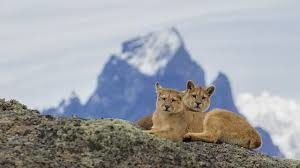 That day, a small herd of guanacos caught my eye, as we flew around and they scampered over the rough countryside. From up high, they were easier to spot than on the ground, but they blended so well with the land around them, they were there one minute and gone the next, only to reappear seconds later bounding over a ridge a hundred yards away. The many streams and creeks didn’t seem to pose any problem to them either, and they crossed water without hesitation. I admired these animals and their adaptation to their home turf; they were as one with the land, a part of it. I had seen herds like this one many times, but much as I looked, I had never seen a puma. According to my friend Antonio, pumas lived mainly on hare and guanaco, with the latter being their favorite prey. To date, I had never seen one in the wild and probably never would.
That day, a small herd of guanacos caught my eye, as we flew around and they scampered over the rough countryside. From up high, they were easier to spot than on the ground, but they blended so well with the land around them, they were there one minute and gone the next, only to reappear seconds later bounding over a ridge a hundred yards away. The many streams and creeks didn’t seem to pose any problem to them either, and they crossed water without hesitation. I admired these animals and their adaptation to their home turf; they were as one with the land, a part of it. I had seen herds like this one many times, but much as I looked, I had never seen a puma. According to my friend Antonio, pumas lived mainly on hare and guanaco, with the latter being their favorite prey. To date, I had never seen one in the wild and probably never would.
“All a puma has to do is stand still and you’ll never see one from the air,” said Antonio to me once when I asked about pumas. “They don’t have the herd instinct of the guanaco and don’t run. What they do is locate their prey during daytime and wait until dark. Easier that way. They stalk from downwind, moving silently, same as a ghost.
“I used to hunt puma when I was a kid,” he went on. “We’d go riding out for several days into the wildest country you ever saw, when we had nothing better to do, and usually got one or two. Pumas live in country that’s good for the eyes but hell on the feet. Back when, there were lots of cats. By ourselves, we had better luck after a big snow, because then you can follow fresh tracks. The rest of the time, you have to use dogs to have any chance at all. It was a way to stay busy and keep the sheep losses down. You see, they like lamb every bit as much as you and me, but they shy away from man . . . which is a good thing. The puma is a true hunter. A solitary cat with fire in his eyes and lots of patience. Big, too, so when the time comes they can deliver the fatal blow. Puma,” he added, “is an Inca word meaning strong and powerful. I learned a lot about hunting and tracking just by watching them.”
Antonio was born in Tierra del Fuego, and was as much a part of the landscape as the guanacos and pumas.

